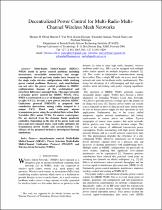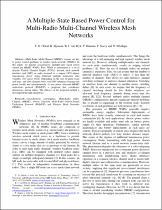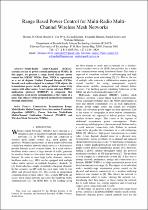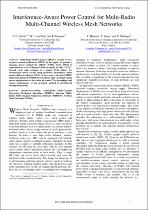 ResearchSpace
ResearchSpace
Decentralized power control for multi-radio multi-channel wireless mesh networks
JavaScript is disabled for your browser. Some features of this site may not work without it.
- ResearchSpace
- →
- Research Publications/Outputs
- →
- Conference Publications
- →
- View Item
| dc.contributor.author |
Olwal, TO

|
|
| dc.contributor.author |
Van Wyk, BJ

|
|
| dc.contributor.author |
Djouani, K

|
|
| dc.contributor.author |
Hamam, Y

|
|
| dc.contributor.author |
Siarry, P

|
|
| dc.contributor.author |
Ntlatlapa, Ntsibane S

|
|
| dc.date.accessioned | 2010-12-07T08:02:12Z | |
| dc.date.available | 2010-12-07T08:02:12Z | |
| dc.date.issued | 2010-09 | |
| dc.identifier.citation | Olwal, TO, Van Wyk, BJ, Djouani, K et al. 2010. Decentralized power control for multi-radio multi-channel wireless mesh networks. Southern Africa Telecommunication Networks and Applications Conference (SATNAC), Spier Estate, Stellenbosch, South Africa, 5-8 September 2010, pp 6 | en |
| dc.identifier.uri | http://hdl.handle.net/10204/4607 | |
| dc.description | Southern Africa Telecommunication Networks and Applications Conference (SATNAC), Spier Estate, Stellenbosch, South Africa, 5-8 September 2010 | en |
| dc.description.abstract | Multi-Radio Multi-Channel (MRMC) WMNs result in power control problems including interference, un-scalable connectivity and energy consumption. Several previous studies have focused on the single radio wireless configurations while studying power control problems. However, such contributions can not solve the power control problems in MRMC configurations because of the architectural and structural differences amongst them. This paper presents a dynamic power control for MRMC WMNs. First, WMN is represented as a set of disjoint Unified Channel Graphs (UCGs). Second, a new power selection MRMC Unification protocol (PMMUP) is proposed that coordinates interactions among radios assigned to a unique UCG. Third, each radio-pair adjusts transmission power using the predicted Interaction State Variables (IVs) across UCGs. To ensure convergence, IVs are derived from the dynamic linear quadratic controller. Depending on the size of the queue loads and intra-and inter-channel states, each radio optimizes the transmission power locally and asynchronously. The efficacy of the proposed method is investigated through simulations. | en |
| dc.language.iso | en | en |
| dc.publisher | SATNAC 2010 | en |
| dc.relation.ispartofseries | Conference Paper | en |
| dc.subject | Asynchronous control | en |
| dc.subject | Multi radio multi channel | en |
| dc.subject | Wireless mesh networks | en |
| dc.subject | Power Selection Multi-Radio Multi-Channel Unification Protocol | en |
| dc.subject | PMMUP | en |
| dc.subject | SATNAC 2010 | en |
| dc.title | Decentralized power control for multi-radio multi-channel wireless mesh networks | en |
| dc.type | Conference Presentation | en |
| dc.identifier.apacitation | Olwal, T., Van Wyk, B., Djouani, K., Hamam, Y., Siarry, P., & Ntlatlapa, N. S. (2010). Decentralized power control for multi-radio multi-channel wireless mesh networks. SATNAC 2010. http://hdl.handle.net/10204/4607 | en_ZA |
| dc.identifier.chicagocitation | Olwal, TO, BJ Van Wyk, K Djouani, Y Hamam, P Siarry, and Ntsibane S Ntlatlapa. "Decentralized power control for multi-radio multi-channel wireless mesh networks." (2010): http://hdl.handle.net/10204/4607 | en_ZA |
| dc.identifier.vancouvercitation | Olwal T, Van Wyk B, Djouani K, Hamam Y, Siarry P, Ntlatlapa NS, Decentralized power control for multi-radio multi-channel wireless mesh networks; SATNAC 2010; 2010. http://hdl.handle.net/10204/4607 . | en_ZA |
| dc.identifier.ris | TY - Conference Presentation AU - Olwal, TO AU - Van Wyk, BJ AU - Djouani, K AU - Hamam, Y AU - Siarry, P AU - Ntlatlapa, Ntsibane S AB - Multi-Radio Multi-Channel (MRMC) WMNs result in power control problems including interference, un-scalable connectivity and energy consumption. Several previous studies have focused on the single radio wireless configurations while studying power control problems. However, such contributions can not solve the power control problems in MRMC configurations because of the architectural and structural differences amongst them. This paper presents a dynamic power control for MRMC WMNs. First, WMN is represented as a set of disjoint Unified Channel Graphs (UCGs). Second, a new power selection MRMC Unification protocol (PMMUP) is proposed that coordinates interactions among radios assigned to a unique UCG. Third, each radio-pair adjusts transmission power using the predicted Interaction State Variables (IVs) across UCGs. To ensure convergence, IVs are derived from the dynamic linear quadratic controller. Depending on the size of the queue loads and intra-and inter-channel states, each radio optimizes the transmission power locally and asynchronously. The efficacy of the proposed method is investigated through simulations. DA - 2010-09 DB - ResearchSpace DP - CSIR KW - Asynchronous control KW - Multi radio multi channel KW - Wireless mesh networks KW - Power Selection Multi-Radio Multi-Channel Unification Protocol KW - PMMUP KW - SATNAC 2010 LK - https://researchspace.csir.co.za PY - 2010 T1 - Decentralized power control for multi-radio multi-channel wireless mesh networks TI - Decentralized power control for multi-radio multi-channel wireless mesh networks UR - http://hdl.handle.net/10204/4607 ER - | en_ZA |








